
NAVIGATE YOUR HOME SAFELY AND EASILY WITH THESE SIMPLE MODIFICATIONS
BY LYNDA SHRAGER
After spending more than a dozen years in the home care arena providing occupational therapy services, my frustration level continued to rise as I was always brought in to treat my patients after the crisis occurred. Whether it was a slip getting into the tub in the bathroom, a fall reaching for the light in the living room, or a loss of balance reaching for something in the kitchen, these often-serious injuries resulting in trips to the emergency room could have easily been avoided.
As an occupational therapist, my treatment practices are guided by the Environmental Press theory, a theory suggesting that the more a person's environment presents challenges, the harder it is to function in that environment. By reducing the challenges, it becomes easier to accomplish activities of daily living, fundamental skills that are required to independently care for oneself. My focus shifted to helping my patients with physical and cognitive challenges make their homes more livable and safer before a crisis occurred. This article highlights the process of conducting environmental home assessments, beginning with observing how the client navigates from the outside in and throughout their home. Those observations are the basis for creating a plan to address any problem areas to help them remain in their homes, aging comfortably and safely in place.
PHOTOS PROVIDED BY LYNDA SHRAGER
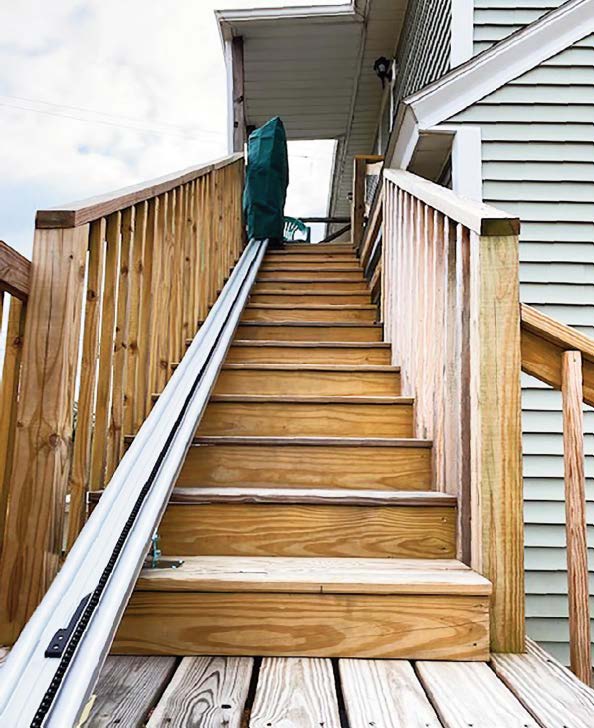

GET OUT THERE: Once the stairlift (left) was installed, the family was able to transfer their mother into the chair to "go for a ride" to the backyard; Another client needed a low, rounded rail (right) which was the optimal size and shape for her to grasp.
ENTRANCES AND EXITS
One of my most challenging scenarios was working with an elderly woman suffering with amyotrophic lateral sclerosis who lived with her daughter. The home was built on a sloping lot that required eight steps to access the front door. The family needed several helpers to get mom up and down several helpers to get mom up and down the front stairs. Since it was often difficult to gather the troops, most of the time she was stuck in her house. The kitchen led out to a back deck that had a long staircase leading down to the backyard. Thinking "outside the house" I suggested that they install a stairlift on the back deck staircase. The family was unaware that this was even a possibility. Stairlifts are not inexpensive, costing between $2000 and $5000. They are covered by some state Medicaid waiver programs and help for financing may be found through foundations and disease-specific organizations. For this family, the benefit was priceless. Once installed, they were able to wheel her out through the kitchen onto the deck, where she could transfer into the chair and "go for a ride" down to the yard. To protect the stairlift in inclement weather, they covered it with a tarp. She was no longer a prisoner in her own home.
Assessments begin with observing the patient's ability to safely enter and exit the home, a simple function that can be surprisingly difficult. Entranceways to homes are as diverse as the homes themselves. The ideal scenario is to have a no-step entrance to the house, also referred to as a zero threshold. This can be accomplished by grading the walkway from the driveway and/or front sidewalk to lead up to the front door via a slow, gradual pitch. Front entrances without a zero threshold usually have some type of stairway leading to either a porch or a platform leading to the front door. I always recommend at least one handrail to assist going up and down the steps. A client was moving into an old farmhouse and, due to a recent stroke, she could not raise her arm high enough nor open her hand wide enough to hold the rail. The solution was to add a lower, rounded railing which was the optimal size and shape for her ability to grasp it.
GENERAL LIVING AREAS
When thinking about safety and mobility throughout the living areas in a house, we often neglect to look closely at the furniture. Arthritic knees and hips and general weakness can wreak havoc on the ability to get on and off of a low, soft cushion. The higher the height of a chair or couch, and the firmer the cushion, the easier it is to get on and off.
Lights, walking surfaces, and windows should be evaluated for safety and convenience. Light switches should ideally be placed in an accessible location near the entrance to a room. Illuminated touch or rocker-type switches are the easiest to use for those with fine motor disabilities. Regular lamps can be eas ily converted to touch-sensitive lamps, which are activated by the touch of a hand rather than by a switch. Good lighting is a key safety feature of any home, and as we age, we need more light.
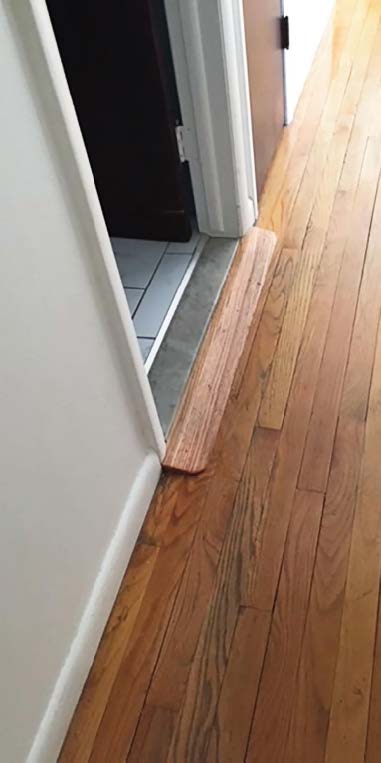

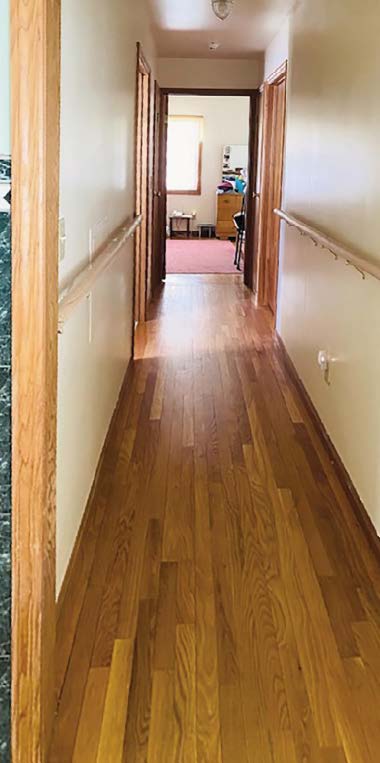
HOLD ON: (Left to right) Door thresholds can ease transitions between rooms; Holding a grab bar made a woman feel safer and more confident accessing this sunken den; Hallway rails can provide much-needed support and security, at night.
The ideal flooring is one that is flat with no changes in surface. For those whose disabilities may lead to impairment in vision and balance, changes in floor surfaces can negatively impact their ability to walk around the house. Door thresholds can be installed in between rooms to smooth out the gaps. If carpeting is preferred, one with a low pile of less than 1/2 inch is optimal. Wood, linoleum, and tile are easier for wheelchair users. These surfaces should be kept clean but not so highly polished that they become slippery. If opting for tile, select a type with texture for more traction.
SUNKEN ROOMS
Sunken rooms come in and out of architectural fashion. One recent assessment involved a friend whose mother-in-law needed to move in for a few months. The kitchen led into a sunken den where she would be spending a lot of time and her Parkinson's made it hazardous for her to get down the two steps. We analyzed where she would need to hold onto for the best mobility, and then added a grab bar under the countertop to provide support. Holding this rail made her feel safer and more confident accessing this room.
HALLWAYS
To increase safety, install a light at both ends of the hallway. Installing a railing in a hallway can provide much-needed support and security, especially for those late-night "runs" from the bedroom to the bathroom.
KITCHEN
The kitchen is often the heart of the home and the place where family and friends tend to congregate. Although a large renovation to alter the size and overall layout may be prohibitive, there are numerous ways to modify areas to make it easier to navigate. In general, an open floor plan makes it easier for two people to be in the kitchen together, and if one is on crutches or using a walker, the wider the open space, the more room to move around. If someone is in a wheelchair, a 5-foot diameter of open space is an ideal turning radius. If counters are not at an ideal height, the kitchen table can be used as a workstation, or a portable kitchen island can be added to the space. If possible, one workstation should be 27 inches off the floor and open underneath, making it accessible for someone who is seated. Consider lowering some cabinets and using D-shaped handles as they are the easiest to grasp for those with decreased strength and mobility in their hands. A side-by-side refrigerator is the easiest for everyone to access, especially someone in a wheelchair.
Bump dots provide a tactile clue for the visually impaired. Appliance knobs can be marked at standard settings with these raised bumps. Use them on washer/dryers, microwaves and ovens.


HANDY HELPERS: Bump dots (left) provide a tactile clue for the visually impaired and can be used on washer/dryers, microwaves and ovens; Bed safety rails (right) assist with sitting, standing and balance when getting out of bed.
BEDROOM
Beds come in all types and sizes, just like the people who sleep in them. The height from the floor to the top of the mattress significantly impacts the ease with which one can get on and off the bed. Generally, the lower the height of the bed, the easier it is to get into. But here's the catch-22: the higher it is, the easier it is to get out of. Ideally, when sitting on the edge of the bed with knees bent at 90 degrees, feet should rest flat on the floor. For the easiest transfers getting in and out of the bed, the height from the floor to the top of the mattress should be around 22 inches. If a bed is too low, elevate it with risers that are available in most home goods stores. If the bed is too high, one option is to remove the rug rollers or wheels on the bed frame to effectively decrease the height by around 2 inches. Switching from a standard box spring to a shallow one could also help compensate for a too-tall mattress. Other options would be to use a frame that eliminates the need for a box spring Search "bed safety rails" for handles that help with moving around in bed and assist with sitting, standing and balance when getting out of bed.
Search "bed safety rails" for handles that help with moving around in bed and assist with sitting, standing and balance when getting out of bed.
BATHROOM
The first thing I look at is the toilet. So much angst surrounds the use of this porcelain receptacle, and for good reason: when you gotta go, you gotta go! While traditional toilets measure less than 17 inches in height, people with joint difficulty or muscle weakness have a much easier time getting on and off toilets with a height between 17 and 19 inches, often referred to as "comfort height" toilets. These are in accordance with Americans with Disabilities Act (ADA) standards and generally found only in newer construction. While many people opt to replace what was often the originally-installed toilet with one that is a more comfortable height, there are other less-costly options to make it higher and safer. Raised toilet seats come with and without arms, and a commode placed over a toilet also works well. Risers are easily installed; many are removable with adjustable knobs, and some are more permanent. Consult with an occupational therapist to determine the best setup. If seat height is not an issue, another option is to add handles on either side of the toilet. The handles serve as an armrest and will provide a gripping surface to help push up off of and lower down onto the toilet.
I next look at the existing type of shower or tub. The best scenario is a walk-in, zero-threshold shower with easily reachable faucets, and grab bars around the entire perimeter, both vertical and horizontal. A girl can dream, can't she? Most falls occur in the bathroom due to slippery floors and transfers and installing grab bars can often help to prevent this. Grab bars come in all sizes, are available angled and straight, and are made of various metals and plastics. If using them inside the shower or tub, I recommend textured ones that do not become slippery when wet. A 24-inch vertical grab bar on either end to grab on to when entering the tub and a 36-inch horizontal grab bar across the back wall will suffice. Installation should be done by someone experienced in drilling into a shower wall. The height of the bar is dependent on the client's abilities and needs. If a person is concerned with balance or does not have the endurance or ability to stand, there are a variety of seats and benches made for showers or tubs to make those environments safer. Regarding using bathmats, try the "Shrager twist test" to determine if the rug is safe. Simply step on the rug with your feet about 12 inches apart, wiggle your hips, and try to do the twist. Music is optional. If the rug moves under your feet, it is not safe. A secure mat requires good rubber backing that will keep it in place and make exiting the shower safer.
STAIRS
To increase staircase safety, install railings on both sides and extend them past both the top and bottom steps. The transition from the last step onto the landing can be difficult, and the extended railings offer extra support in both directions. Good lighting is essential on staircases. As we age, our vision gets worse, and it becomes more difficult to discern where one step ends and the next begins. If stairs can't be navigated a stairlift can be installed.•
ABOUT THE AUTHOR:
Lynda Shrager is a registered occupational therapist with a Master's degree in social work and is a certified aging in place specialist. She is the CEO of At Home for Life, a business that helps seniors safely and successfully age in place. She authored Age in Place, A Guide to Modifying, Organizing and Decluttering Mom and Dad's Home. (Bull Publishing, 2018). Lynda presents workshops on all aspects of aging. Learn more at otherwisehealthy.com
TRY THIS : FAVORITES HACKS FOR HEALTH & HOME
THE EXTERIOR
• House numbers should be big, contrast with the exterior color, and be easy to read and locate. This is especially critical should first responders need to find your house.
• If expecting guests, keep the automatic garage door opener with you in the house. You can let people in without getting up to go to the door.
LIVING AREAS OF THE HOME
• When choosing lighting fixtures, purchase ones that use 3-way bulbs so that you can increase the lighting using a single switch.
THE KITCHEN
• The kitchen sink is an option for those who have difficulty accessing the tub or shower. Place a tub chair in front of the sink to facilitate a nice sponge bath. Fill a spray bottle with warm water for a mini shower.
• One-handed cutting boards exist with spikes to hold food for cutting and corner pieces to secure bread for spreading.
• Place a pants hangar over a cabinet knob and use the hooks to secure a recipe for easy viewing.
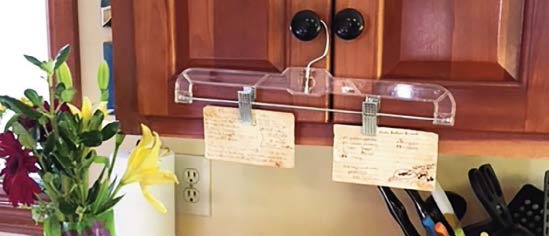
THE BEDROOM
• Over-the-bed tables are not just for hospital rooms. These provide a handy, adjustable-height surface that can hold needed items next to the bed. These tables also work well in any room of the house.
THE BATHROOM
• A thick, thirsty terry cloth robe to put on after bathing will absorb most of the moisture, making drying off easier.
• For the memory impaired, use automatic night-lights to illuminate the path to the bathroom.
•Place needed bathing items in a bin within easy reach.
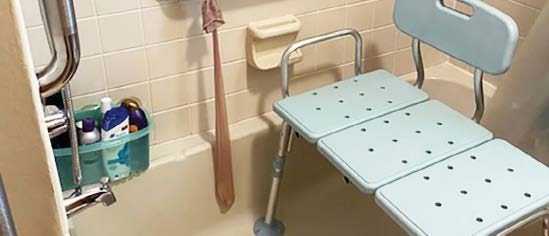
•My favorite bathroom tip: Take a lady's stocking or pantyhose and cut a leg off. Place a bar of soap in the foot and tie the "soap on a rope" to the towel bar or grab bar in the tub or shower. Wash yourself right though the stocking and never drop the soap again!